What was I thinking?!
Sake-Poached Asian Pears with Ume and Li Hing Sauce
It all started when one of my friends emailed me the link to the Pear Recipe Challenge at Santana Row. Basically, people enter a recipe using pears, and 5 of them would be chosen to present their recipes before a panel of judges (one of the judges is going to be FoodGal, Carolyn Jung) at the Pear Festival at Santana Row on October 19. The winner would get a cookbook, a restaurant gift card, a shopping spree, and their name in lights, (well, okay, their name on the SR website…close enough). It got me thinking because I recalled seeing this amazing picture of a poached pear in "Working the Plate" by Christopher Styler and wanting to do a poached pear myself.
So I thought I’d do a little twist on poached pears by poaching Asian pears instead of the normal Bosc or Bartletts. I looked around on Food Blog Search, and found that Burnt Lumpia had done a poached Asian pear recipe calling for Riesling wine and pandan leaves. Also, Mark Bittman had done a poached Asian pear recipe calling for classic Asian spices such as star anise and cinnamon, but no wine.
I wanted to take a different tack, though. I wanted to make Li Hing Poached Pears. Li Hing is a sweet-salty, dried plum that is highly addictive. Once you start eating li hing, it’s hard to stop. In Hawaii, we like to eat lots of food that has been flavored with li hing powder, like shave ice, hurricane popcorn, and pickled mangoes. Why not pears?
If at First You Don’t Succeed
So my first attempt called for peeling a whole Asian pear, coring it, and poaching it for half an hour covered in a poaching liquid consisting of water, dry white wine, sugar, and li hing powder. I poached it for about 40 minutes, until a I met little resistance when I stuck it with a paring (pearing? LOL boy do I love puns) knife.
Li Hing Poached Asian Pear
The outside of the pear was tinted with the reddish color of the li hing but inside was still white. I guess I should’ve read the rest of the recipe and let the pear cool overnight in the poaching liquid. But I was too eager to taste it, so I ate it hot. (What can I say? The boy has no patience.)
So the flavor of the li hing poached pear was ehhh… It didn’t really have as strong a li hing hit as I would have liked. I did boil down the poaching liquid and made a rocking li hing sauce though. Back to the drawing board.
Try, try again
Annie suggested I try poaching the pears in Japanese sake instead of wine, and flavor it with ume. I also took a suggestion from the pear vendor at the farmer’s market and try an oven-poaching method that she saw in Parade Magazine. Here’s my mise: umeboshi, brown sugar, Asian pears, a lemon, and some sake.
Ume, Brown Sugar, Asian Pears, Lemon, and Sake
First, I preheated the oven to 375*F. Then I peeled the pears, halved them, and took the cores out with a melon baller.
Asian Pears, Halved and Cored
Meanwhile, I combined a half cup of sake, a half cup of water, 3 tablespoons of brown sugar, 4 umeboshi, and the juice of one lemon in a round, 9-inch cake pan. I stirred it to combine,then placed the pears cut-side down in the liquid and brought it to a boil on the stove.
Asian Pears Boiling in Sake Mixture
I covered the pan with foil and placed it in the oven to bake for 40 minutes. After they were done,I removed the pan from the oven, let the poached pears cool to room temperature, then placed the pan in the fridge to chill.
The next day, I sliced the poached pears up and served them on individual plates, drizzled with some li hing sauce and garnished with an ume.
Sake-Poached Asian Pears with Ume and Li Hing Sauce
So, how’d the poached Asian pear taste? Like a very soft, sweet pear. I could detect both the sake and ume notes in each bite. The li hing sauce gave it a salty edge which was pleasing to me. Other tasters, though, said it was "interesting".
Now, when someone says a dish is "interesting," it’s a sure sign that the recipe won’t have mass appeal. (Strangely enough, I get that a lot when I cook…I wonder why…) So I decided that it would probably not be a good idea to enter the poached Asian pear recipe in the Pear Challenge. This recipe may be original, and I could probably work on making the presentation look better. But I’m not sure how much effort I would want to put into a competition dish that probably won’t appeal to mass tastes.
So here it is, food lovers: my evolved but not ready for prime time Sake-Poached Asian Pears with Ume and Li Hing Sauce. Leave a comment and tell me what you think!
Aloha, Nate
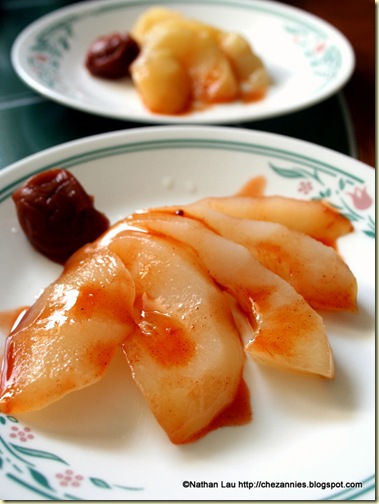
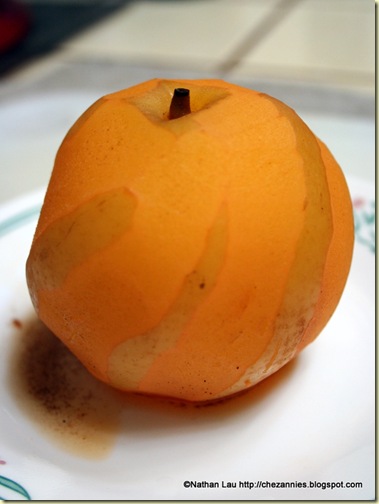
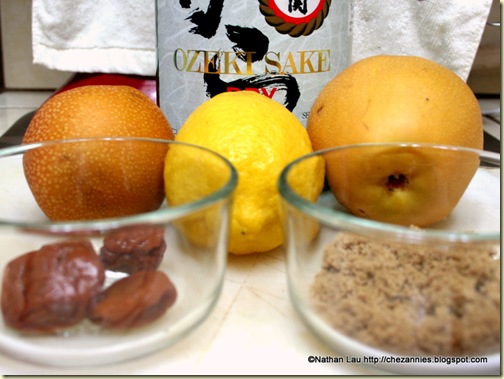

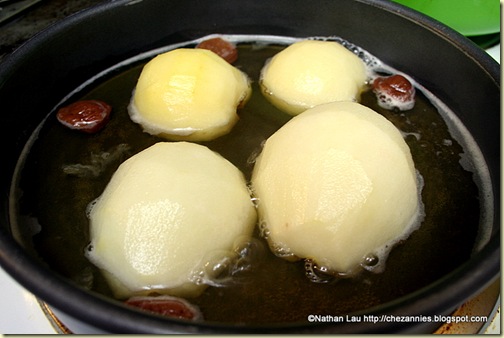
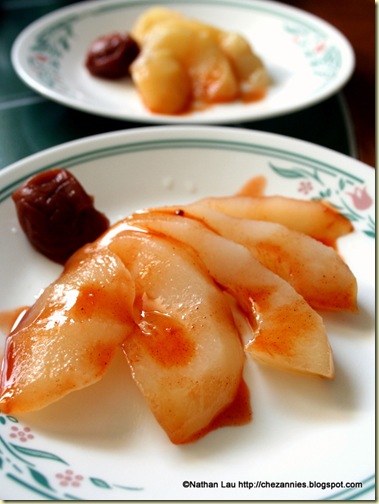
>It looks beautiful and sounds, well yes interesting but unique and delicious, maybe you should pair it with something creamy as well, either ice cream or whipped cream. And you could make a complementary flavor. (not sure what that would be–but I know you are creative and will make it perfect for the day of the contest.)
>I think li hing mui is defintely an acquired taste, although it’s not a hard one to acquire! I have a bag of li hing powder in my pantry and you’ve inspired me to make a sauce.
>@Manger – I did have some with vanilla ice cream…it didn’t work unfortunately. I think with li hing you need something tart. Maybe a lemon sorbet or something.
@Jenster – what are you doing with a bag of li hing powder?
>@Jenster – what are you doing with a bag of li hing powder?
I picked it up at Long’s Drugs/Kahala Mall during a holiday visit with family last year. I was going to sprinkle it on top of my fruit. Then I put it into my pantry and promptly forgot about it. (Can you believe that?) Needless to say, my pantry is in need of a good organizing.
>Whoa – this looks so good. I’ve done poached pears before, but had never thought to Asianify it. Nicely done!
>Oh, I love the taste of Li Hing. It makes me think of my childhood, chewing on those Chinese dried plums with the sweet-salty flavor. Does anyone know: Can you find the powder easily like at 99 Ranch or a similar Asian market?
>@jenster – our pantry needs organizing too. I don’t know what is in there that needs tossing out! where in hawaii does your family live?
@lilly – thanks!
@carolyn – I don’t recall seeing the powder at 99 Ranch. Do you call it “li hing” too, or by some other name?
>I just had an Asian Pear left, but a coupla days back I peeled it and we had it cos I felt very thirsty… Missed your post then, anyways I shall pick a few Pears this weekend and save them for your recipe 😉
>@Ramya – let us know how it turned out!
>To be honest, I’ve only known it as li-hing in the past few years. I know the actual salted preserve plum as “muoy” or however you spell it. 😉
Whatever it is, it’s GOOD! 😉
>@Carolyn – in Hawaii, it was called “C-Mui” as well as “li hing mui”.
>Beautiful and yummy!
>@van – thanks!